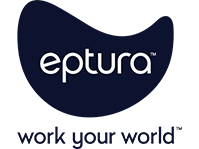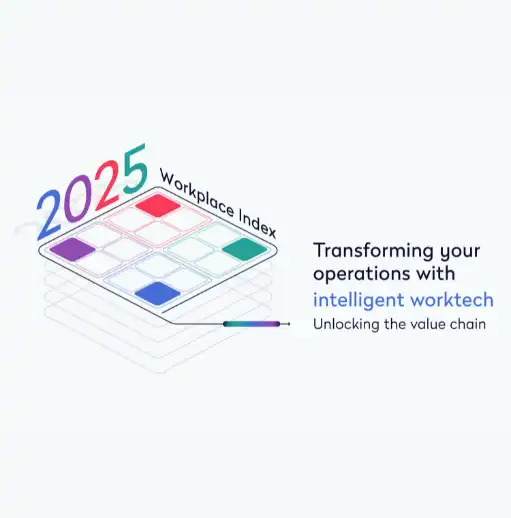
Productivity is no longer a function of hours worked or desks occupied. In 2025, organizations are shifting away from measuring output through physical presence and toward understanding how, when, and where people work best. Fueled by hybrid models, smarter worktech, and AI, the conversation around workplace productivity has evolved. What matters now is how integrated, intelligent, and human-centered your workplace ecosystem really is.
But with more data, tools, and systems than ever before, are companies actually becoming more productive, or just more distracted?
The numbers behind modern productivity
Recent data paints a nuanced picture. According to ActivTrak’s latest State of the Workplace report, the average workday has shortened by 36 minutes compared to pre-remote norms, yet productivity has ticked up by 2%. Interestingly, remote-only employees report being more productive than their hybrid or in-office peers, gaining about 29 minutes of productive time per day.
However, that’s not the full story. Workers are interrupted roughly every three minutes, and it takes an average of 23 minutes to fully regain focus after each one. While AI is becoming more embedded in daily workflows — used by 58% of employees in 2025, up 107% since 2022 — users also report longer workdays and reduced focus time when AI is not carefully managed or integrated.
The takeaway? Productivity gains are real, but fragile. Without intentional design, digital overload and tool fatigue can easily offset the benefits.
A broader lens: Productivity in the context of organizational strategy
Eptura’s 2025 Workplace Index Report reinforces that productivity isn’t a stand-alone metric — it’s a byproduct of smart, cross-functional alignment. In a survey of 200 enterprise leaders across operations, real estate, and IT, productivity ranked as one of the top three workplace priorities, alongside optimizing space and leveling out occupancy across the workweek.
But here’s the catch: 50% of businesses are using an average of 17 disconnected worktech solutions, while only 4% have fully integrated platforms. That disconnect directly affects productivity, with 37% of organizations now requiring 11 or more full-time employees just to collate, analyze, and report on operational data across systems.
The real barrier to productivity isn’t a lack of technology, it’s fragmented systems and poor integration, something that companies like Eptura are guiding enterprises to overcome.
The integration imperative
So what’s the fix? It starts with recognizing that productivity is no longer about doing more, faster. It’s about creating environments where people can work with less friction, fewer interruptions, and more focus — supported by tools that speak to each other.
This is where integration comes into play. As highlighted in the Workplace Index, businesses that successfully connect their worktech systems see measurable gains not just in productivity, but in cost savings, space efficiency, and even asset lifecycle performance. With unified platforms and centralized data, companies gain:
- Clearer insights into how work happens
- Faster decision-making
- Smarter, AI-driven automation
- Reduced administrative load on teams
This convergence is what Eptura calls the Intelligent Worktech Value Chain — a system where being more connected leads to being more informed, and ultimately, more productive.
Employee experience: The productivity catalyst
It’s no coincidence that 42% of businesses rank employee experience as the area with the highest potential for value creation through digital transformation. That’s more than asset management, space planning, or even real estate.
Why? Because productivity happens at the human level. And today’s workforce — especially younger employees — expects digital fluidity. Gen Z already makes up 18% of the workforce and is pushing organizations to trade paper-heavy processes for automation, mobile apps, and personalized work environments.
In response, as documented in the Workplace Index report, 67% of financial and professional services firms have already hired digital workplace leaders to better orchestrate employee experience. From desk booking and indoor navigation to real-time notifications and collaboration planning, the goal is to eliminate decision fatigue and put control back in the hands of employees.
AI and the productivity paradox
AI is undeniably shaping the future of work — but not without complications. While the Workplace Index report cited that 70% of businesses use AI for dashboards and chatbots, more advanced use cases like predictive space planning and building automation are still underutilized.
According to the Workplace Index, AI delivers the most value when it’s fueled by clean, centralized data. Without that foundation, organizations face common obstacles:
- Poor cross-platform integration (reported by 52% of leaders)
- Inconsistent data quality (48%)
- Lack of internal AI expertise (58%)
To move from experimentation to value, businesses need to embed AI into workflows that genuinely reduce cognitive load — automating routine tasks, recommending the best days to collaborate in person, or surfacing building inefficiencies in real time. Otherwise, AI risks becoming just another layer of complexity.
Space, place, and time: The new productivity toolkit
It’s not just digital tools that drive productivity — it’s how people interact with physical space. Data from the Workplace Index shows a 33% global increase in desk bookings per building year-over-year. And with 34% of businesses planning to increase in-office days in 2025, there’s pressure to get space optimization right.
But the return to office isn’t evenly distributed. Bookings still peak Tuesday through Thursday, creating “midweek mountains” of demand. Intelligent systems that help level occupancy, visualize real-time capacity, and guide employees to the best environments for their tasks will be key to reducing friction and improving output.
This kind of responsiveness — where workplace design adapts in real time to human needs — is the future of productivity.
Toward smarter, not busier
Workplace productivity in 2025 is not about squeezing more hours from employees or piling on digital tools. It’s about systems that reduce noise, prioritize human experience, and connect the dots between people, place, and purpose.
Organizations that lead in this space won’t necessarily be those with the most technology — they’ll be the ones who simplify, integrate, and empower. Find out how Eptura Engage (Condeco) can help you achieve this.




